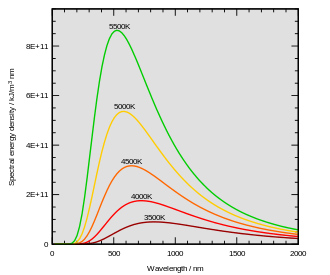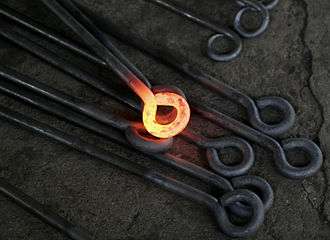Red heat
The practice of using colours to determine the temperature of a piece of (usually) ferrous metal comes from blacksmithing. Long before thermometers were widely available it was necessary to know what state the metal was in for heat treating it and the only way to do this was to heat it up to a colour which was known to be best for the work.
.svg.png)
The visible color of an object heated to incandescence (from 550°C to 1300°C).

The peak wavelength and total radiated amount vary with temperature according to Wien's displacement law. Although this shows relatively high temperatures, the same relationships hold true for any temperature down to absolute zero. Visible light is between 380 and 750 nm.

Thermal radiation in visible light can be seen on this hot metalwork.
Chapman
According to Chapman's Workshop Technology, the colours which can be observed in steel are:[1]
| Colour | Temperature [°C] | Temperature [°F] | ||
|---|---|---|---|---|
| From | To | From | To | |
| Black red[2] | 426 | 593 | 709 | 1010 |
| Very dark red | 593 | 704 | 1010 | 1210 |
| Dark red | 704 | 814 | 1210 | 1408 |
| Cherry red | 815 | 870 | 1409 | 1508 |
| Light cherry red | 871 | 981 | 1510 | 1708 |
| Orange | 981 | 1092 | 1708 | 1908 |
| Yellow | 1093 | 1258 | 1910 | 2207 |
| Yellow white | 1259 | 1314 | 2209 | 2308 |
| White | 1315+ | 2309+ | ||
Stirling
In 1905, Stirling Consolidated Boiler Company published a slightly different set of values:[3]
| Colour | Temperature [°C] | Temperature [°F] |
|---|---|---|
| Red: Just visible | 525 | 977 |
| Dull red | 699 | 1,290 |
| Dull cherry red | 800 | 1,470 |
| Full cherry red | 900 | 1,650 |
| Clear cherry red | 1,000 | 1,830 |
| Deep orange | 1,100 | 2,010 |
| Clear orange | 1,200 | 2,190 |
| White heat | 1,300 | 2,370 |
| White bright | 1,400 | 2,550 |
| White dazzling | 1,500 | 2,730 |
gollark: Yes, this is somewhat distorted due to Canadian spatial manipulation weapons.
gollark: Oh, of course.
gollark: Actually, the equator consists of liquescent bee storage only.
gollark: Actually, this is America.
gollark: ↑ you
See also
References
- Chapman, W. A. J. (1972). Workshop Technology, Part 1 (5th ed.). Burlington, MA: Elsevier Butterworth-Heinemann. ISBN 978-0713132694.
- When viewed in dull light.
- A Book of Steam for Engineers. Stirling Consolidated Boiler Company. 1905. p. 50. ASIN B006RXDG3W.
This article is issued from Wikipedia. The text is licensed under Creative Commons - Attribution - Sharealike. Additional terms may apply for the media files.